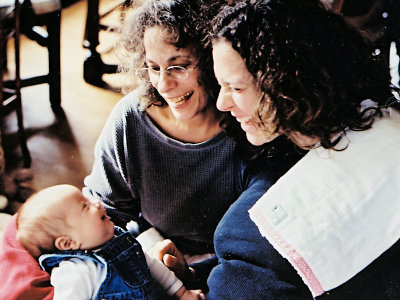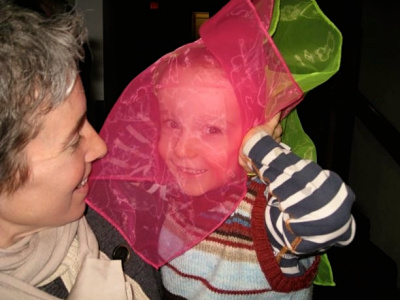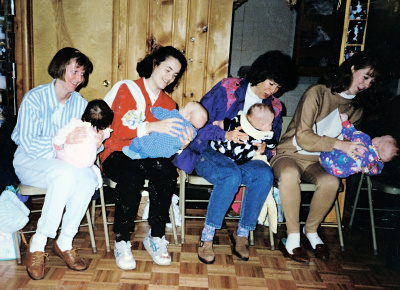
Music In Bloom
In Tune With Babies
by Gari Stein
Many of us in CMN lead music and movement classes. A class is defined as “the teaching of a subject,” but I find that babies are in a class all their own. Reflecting over several decades of working with babies, I find it is I, the student, who learns directly from these precious ones.
I describe my Nurturing Baby and You: For Infants to Pre-walkers as a music and support group rather than a class. It’s about much more than just the music. It is about relationships, the bond between baby and significant other. We can help preserve the musical traditions that Grandma and Grandpa used to pass down in kitchens and on the front porch.
Music and movement can be the infant caregiver’s best friend. A tool readily available, at no cost, can instantly transform a cranky environment into one of joy and calm. In any situation, a simple song can help slow things down and bring folks together.

Not only does music make us feel good, the research is bursting with just how good it really is. Regardless of where children are developmentally, music and movement is nourishment for the brain while impacting all developmental domains. Music is one of the only activities that stimulates and activates both sides of the brain at the same time. And it’s not just for the babies. It’s for us, too. At my age, I know I want both sides of my brain activated at all times (Tuck 2012).
The brain science is exciting, but we need to be careful. Our society is going a little crazy trying to change the way children learn. The media would have us believe that children need to be smarter faster. As educators and musicians, it’s easy to jump on the academic bandwagon, emphasizing early literacy and math skills before children are developmentally ready.
What’s the hurry? It seems as if we start preparing children for college as soon as they are born. Preschool has now become kindergarten, and kindergarten first grade. Studies are showing that rushing children is simply not in their best interest. Children need to run and jump, climb and dance. We need to “be here now” and let the children play!
What about those babies? I am often asked, “So what can babies do?” My answer is always the same. Plenty! Did you know babies’ brains double in size during the first year? What an opportunity to bathe them in the sounds of music.
When we take the time for quiet observation—and I mean quiet, with no adults’ chitchatting—we can see how competent babies are. They look around—pause. Observe—pause. Examine nearby faces—pause. This is what babies do. They don’t need mobiles to entertain them, or us to shake bells and rattles in their faces (Feierabend 1996).
In our little nest, we begin with quiet observation, which also helps adults to settle in. Remember, many of these folks may be overwhelmed, sleep deprived, young or new to the community, or just learning English. Some come with baby development in mind, but many come just to get out of the house and interact with other new parents. I once thought of new parents as either competent or at risk. I now realize that all new parents are at risk, and in this intimate, safe setting, time to share and an understanding nod can go a long way.
“I once thought of new parents as either competent or at risk. I now realize that all new parents are at risk, and in this intimate, safe setting, time to share and an understanding nod can go a long way.”
After we are quiet for a bit, I gently start singing, first to the group and then to each baby by name. “Let’s sing hello together. Hello-hello-hello.” Floor activities may include rolling, lots of rocking, gentle bounces, massage and nursery rhymes, toe- and finger-plays, chanting patterns of bahs and bums, singing melodies without words, tummy time, and periods of silence in between.
In Dear Parent: Caring for Infants with Respect, Magda Gerber talks about not surprising babies by picking them up from behind or tapping on their heads—actions we might not enjoy being done to us. Telling baby what we are going to do before we do it may seem silly. But for me, it’s a way of approaching babies that I suggest you try to incorporate.


We waltz, meet up with other babies to say hello or touch toes, then waltz away; take sheet rides (babies on backs or tummies until sitting on their own); and folk or circle dance. Scarves provide a simply wonderful opportunity for peek-a-boo. To the tune of “Bow, Bow, Bow, Belinda” we sing,
Peek-a-boo. Where is____?
Peek-a-boo. Where are you?
Peek-a-boo. Where is _____?
Peek-a, peek-a, peek-a…booooooo.
Dr. Casper Addyman, a baby laughter researcher at Birbeck College, tells us, “Peek a boo is all the best things. It’s mummy reappearing, but it’s also about shared communication (Lacey 2014).”
We are all ready for a nap now as we return to our little nest and settle down into a quiet place, wrapped in a lullaby.
Go to sleepy baby bye.
Go to sleepy baby bye.
Mama’s gone to the mail boat,
Papa’s gone to the mail boat, bye.
Then,
Wiggle, wiggle fingers
Waaay up to the sky.
Wiggle, wiggle fingers.
Wave them all goodbye.
Again a pause, a moment, to give babies some space. I wait to see if anyone has a concern to share, which is often the case. If not, I may mention something I observed, or an event or article I read. I step back and let folks take it from there, which can turn into a good half an hour or longer.
It is nearly impossible to adequately describe the impact of this special group. Adults—grateful for this time with each other and the opportunity to witness minute nuances from their babies that might otherwise be missed—learn tools to take home. Babies—content and showing caregivers how truly competent they are—enjoying each other. And then there’s me—teary eyed, deeply moved. We begin as strangers, and in the end find ourselves joined together with the music and movement. I encourage anyone remotely interested to give it a try. Do not be afraid!
“A simple song is a powerful tool. I tell my folks, ‘When all else fails, try singing and dancing.’”
We can safeguard children, help to preserve their childhood, be their voice. The Gesell Institute for Child Development cites that developmental milestones of young children have not changed in 100 years. Children need to know and experience love, trust, and safety, to be read and sung to. They need open-ended process art to develop problem-solving skills, self-regulation, social competency, and emotional well-being. Many children are simply over scheduled and over structured. Children need time to just be (Strauss 2014; Lecker 2014).
A simple song is a powerful tool. I tell my folks, “When all else fails, try singing and dancing.” It really works. No expertise needed.